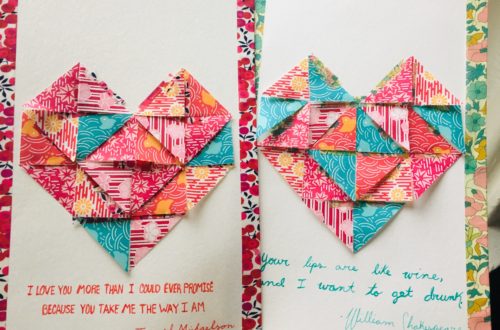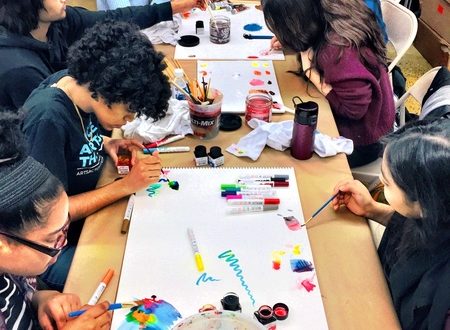As kids mature, how do their creative interests develop? What art supplies are they drawn to and why? Parents at MacPherson’s offer unique insight—not only because they are moms, dads, aunties and uncles, but also because throughout their time here they have tried out more than a handful of the 50,000 art supplies we carry. They’ve got a breadth of product to bring home and a depth of knowledge about it. They take note of an hour long, focused session with one material and a ten minute joy ride with a supply that is then tossed away.
In part one of this series on kids and art supplies, we explored how specific art supplies develop motor skills and how the quality of product often parallels quality time. Naturally as children get older their interest in art supplies grows more refined. “It’s the difference between enjoying smudging the crayons into the paper and coloring,” Category Manager Lacey Elia points out. While children over five still enjoy color-mixing, textures and sensory play, they are ready to put what is in their imagination down on paper.
The Thin Line Between Toys & Crafts
As kids get more confident with art-making, they often discover unconventional ways to use art supplies. For instance, Graphic Designer Tali Even-Kesef’s 11-year-old son Simon loves hot gun glue sticks—but he doesn’t use them in the way you might think. He melts them down to make three-dimensional characters, painting the finished work with markers. Tali’s other son Eli is constantly cutting up paper and taping it back together, creating just about anything.
Knowing what individual kids love to play with will help you assist customers who are browsing. Chat with parents and other adults shopping for kiddos to learn about what that particular kid loves to play with. Put yourself in their shoes: what art supply could be repurposed to enhance their play and spark a sense of ownership over their toys? Sometimes, if a kid is on a particular kick, it helps to know about their obsession (in Simon’s case, DIY figurines) so you can help parents pick the best supply to encourage their interests.
Game Changers
Erasable colored pencils. “This way, it is easy for my son to erase his artwork without having to outline it first with the regular pencils,” Digital Asset Manager Iqvinder Singh says. As kids get older, they typically get a little less Jackson Pollock and a little more Chagall. Translation: they care about coloring in the lines. They might want their work to look a bit more realistic.
Anything scented. What is it about scented school supplies? As a 90s baby, I vividly remember my first set of Mr. Sketch markers. It was the 2nd grade and I was learning cursive, stubbornly using the Blueberry marker, which made the stressful exercise slightly more pleasant. Pens that smell like fruit, erasers that smell like candy, rulers that smell like vegetables…kids love it all!
Crayola markers and large Newsprint Pads! Especially handy when the little artist in question likes to create in bulk. Crayola markers are juicy, make thin and thick lines and last a long time. When kids are just discovering how much they like to color and draw, now is the time for economical paper. With the large newsprint pads, kids will spend a ton of time on one page! It’s nearly as tall as them, with the added bonus that it is recycled and recyclable.
3D over 2D. 3-dimensional forms are more satisfying and inspiring for kids to work with: the form is already there. “My kids enjoy working on canvas or painting the papier mache forms more than a sheet of paper; they like producing a finished project,” Customer Service Manager Rudy Gomez notes. Tali’s family keeps a lot of mannequins around the house, but not as references. “They are like Barbies for the kids,” Tali says. The kids decorate them in all kinds of ways, coloring directly on them, adding sculptural elements, outfits, etc. Some recommendations? A Squishy Soap Dough Kit, kits for baking or DIY craft kits.
Kits happen. For elementary aged children, kits provide a comfortable combination of structured guidance and open-ended inspiration. Self-contained projects and all-inclusive kits also provide a bit of logistical relief for the parents. “My daughter recently got into fashion design sets like from Fashion Angels or Creativity for Kids; she loves using templates to make an outfit,” Lacey says. Daisy adds that rather than going somewhere to buy individual items for a craft, a container with all the accessories is just so much easier for her family.
Creative Sponges
As kids grow older, new influences begin to shape their creative spirit. Suddenly there is a social element to creating art: at school, during summer camp or on playdates. Kids want to create things with and for their friends. Daisy mentions that her daughter has just started knitting with a club that gathers during recess. What kind of programs are your customers’ kids involved in? Find out and discover which supplies you carry that could be a good fit. Kits that produce finished items kids can share, swap or give as gifts are a big hit! And to follow up on our earlier article, unicorns are pretty popular across all age groups!
Another item several parents pointed out? Oil pastels. Kids love the rich colors and the smooth texture. “My five year old was exposed to pastels at his after-care program. He really enjoys color, so I got a set of 50 pastels so he can try them all!” Lacey points out that the Faber-Castell Gel Crayons are always a hit at her house. In addition to social experiences and school, kids are influenced by what the parents are doing at home. “We’re always doing DIY home projects like refinishing, home renovations, homemade holiday decorations and holiday baking projects,” Lacey points out. Her daughter has seen how her family can transform everyday objects in their home and even bake them from scratch! Customers in your store may need help connecting the dots; when they are browsing for children’s items, ask them what creative projects they are working on at home and how their child might participate in their own way. There may be a particular creative material that can assist in making that connection with their child.
A Room of Their Own
Whether it’s a cozy spot on the floor, an art table with all the bells and whistles or a designated nook in the garage, having a dedicated spot where kids feel comfortable and at ease makes art-making accessible and fun. Some kids like to be in the thick of it while they create; some prefer a quiet corner. “At my son’s art table in the middle of the living room we have chenille stems, beads, tapes, scissors, markers,” Tali says. “My son is in kindergarten now, so I got him a new set of STABILO colored pencils for him to do his homework with.” She adds, smiling, “maybe he will show interest in that.”
Consider setting up a kids art table in your store, with all the essential surfaces, a few fun kits and favorite drawing, painting and coloring tools. Maybe it is clean and tidy, drawing the interest of browsing parents. Maybe it is messy and full of testers, catching the eyes of your most important customers: the kids! Invite them to get into creation mode–focused and in the zone, with supplies spread out within arm’s reach.
The Age of the Internet
Kids who are old enough to use phones, tablets and technology of any kind will know how to pull up YouTube. For the kids who engage with arts and crafts regularly, this means tutorials. MacPherson’s parents report that kids are drawn to DIY videos, demonstrations on how to improve technical skills, seasonal craft ideas, creative pranks like creating a fake zombie hand to scare friends.
“My kids will make stuff and watch the videos at the same time,” Daisy says. How can you take advantage of this trend? Set up a (secured) tablet or monitor with a YouTube playlist of kids crafts, drawing tutorials and other fun content on a loop in your children’s section! Remember the success Sam Flax in Orlando had with their On The Spot videos, filmed in the store and played on a quiet yet engaging loop by the point of sale. You could spotlight a different video every so often and display items featured in the video nearby. Make sure to keep the volume low so that the videos are not too intrusive.
Check out part three in our Kids & Art Supplies series, where we focus on teens!
How do you engage with customers who are shopping with and for children? What have you learned from your children’s section? Do you have parents on staff who have shared words of wisdom recently? Share your stories with us at artdogblog (@) macphersonart.com.






